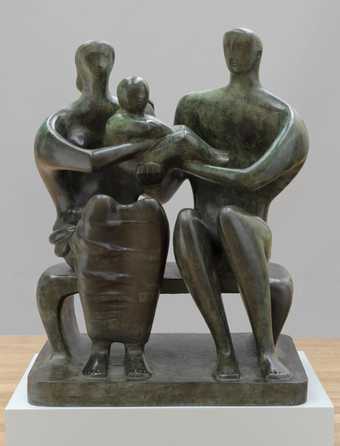
Henry Moore OM, CH, Family Group 1949, cast 1950–1. Tate. © The Henry Moore Foundation. All Rights Reserved.
Henry Moore
14 rooms in Modern and Contemporary British Art
From the comfort of family to the destruction of war, Moore’s sculptures and drawings explore enduring subjects
Henry Moore knew he wanted to become a sculptor from an early age. However, at 18, he enlisted to fight in the First World War. After the war, an ex-serviceman’s grant allowed him to enroll at art school in Leeds and he later studied at the Royal College of Art, London. Moore’s drawings and sculptures reveal a wide range of influences and provide insight into his experiences and interests. But for Moore, art was more than a means of expression, he believed it should serve society. He stated that ‘sculpture, even more than painting... is a public art’. This conviction informed both the scale and subject matter of his work.
His experience of two world wars and the threat of nuclear warfare had a profound impact on Moore. Many of his works explore the frailty of the human body in the context of such conflict. He also produced work that reflected his commitment to activism. In 1958, Moore became a founding member of the Campaign for Nuclear Disarmament (CND).
Family was an enduring subject for Moore, something he returned to throughout his career. This ongoing interest suggests the strength and comfort of family can endure the atrocity of war. Moore saw some of his work as a reflection of his own happy family life, but he also understood the power of the viewer. He said: ‘Part of the excitement of sculpture is the associations it can arouse, quite independent of the original aims and ideas of the sculptor.’
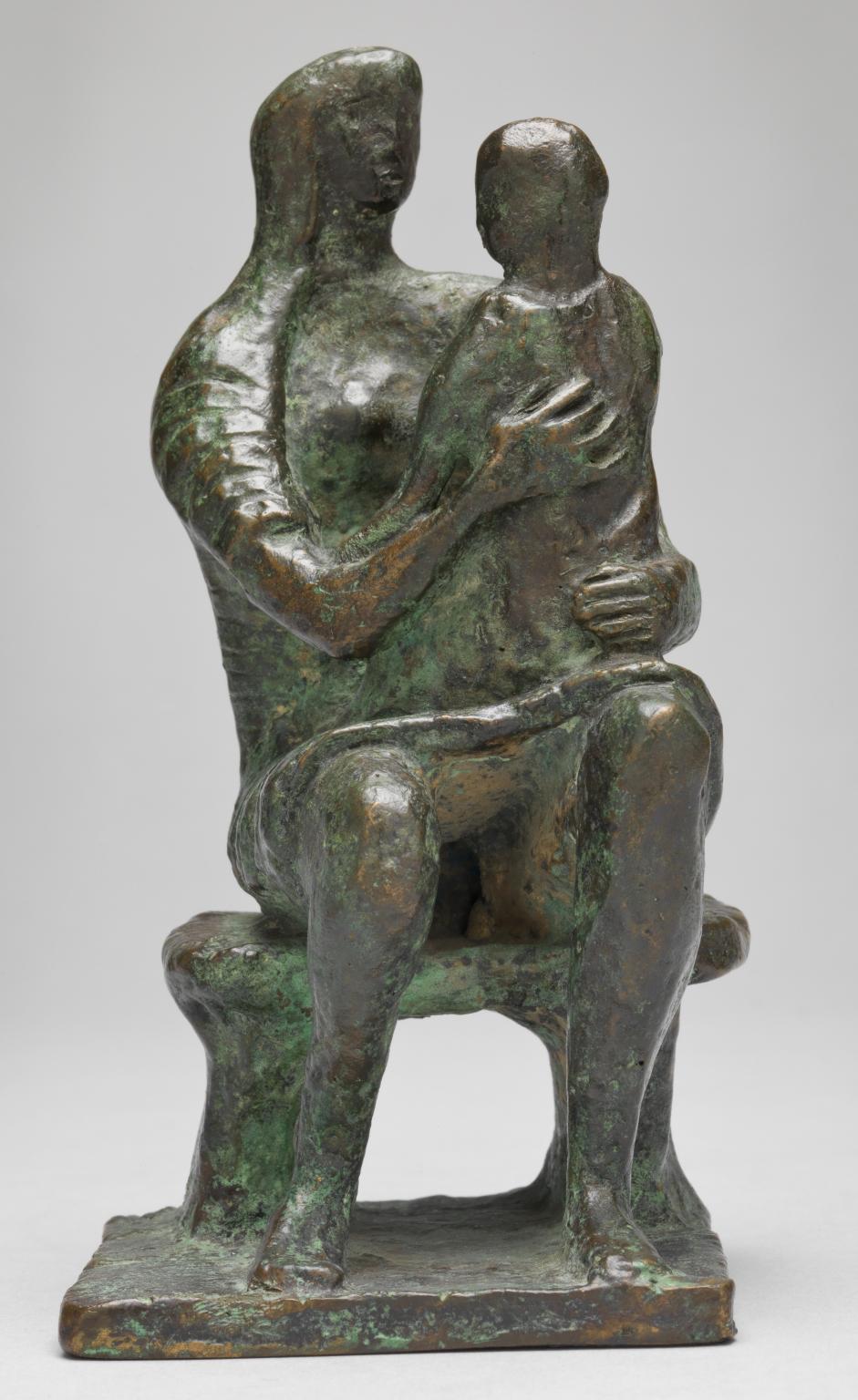
Henry Moore OM, CH, Maquette for Madonna and Child 1943, cast 1944–5
The mother and child had been a major theme in Moore’s work since the 1920s. Yet when the vicar of St Matthew, Northampton, invited Moore to make a sculpture of the Madonna and Child, he was reluctant to accept. He felt unsure how to adapt his secular interests to the Christian tradition. These bronzes are casts of the original terracotta models he made for the project. They are unusually naturalistic and steeped in references to Renaissance religious art. This suggests Moore was trying to produce a sculpture that people would find both modern and familiar.
Gallery label, September 2016
1/24
artworks in Henry Moore
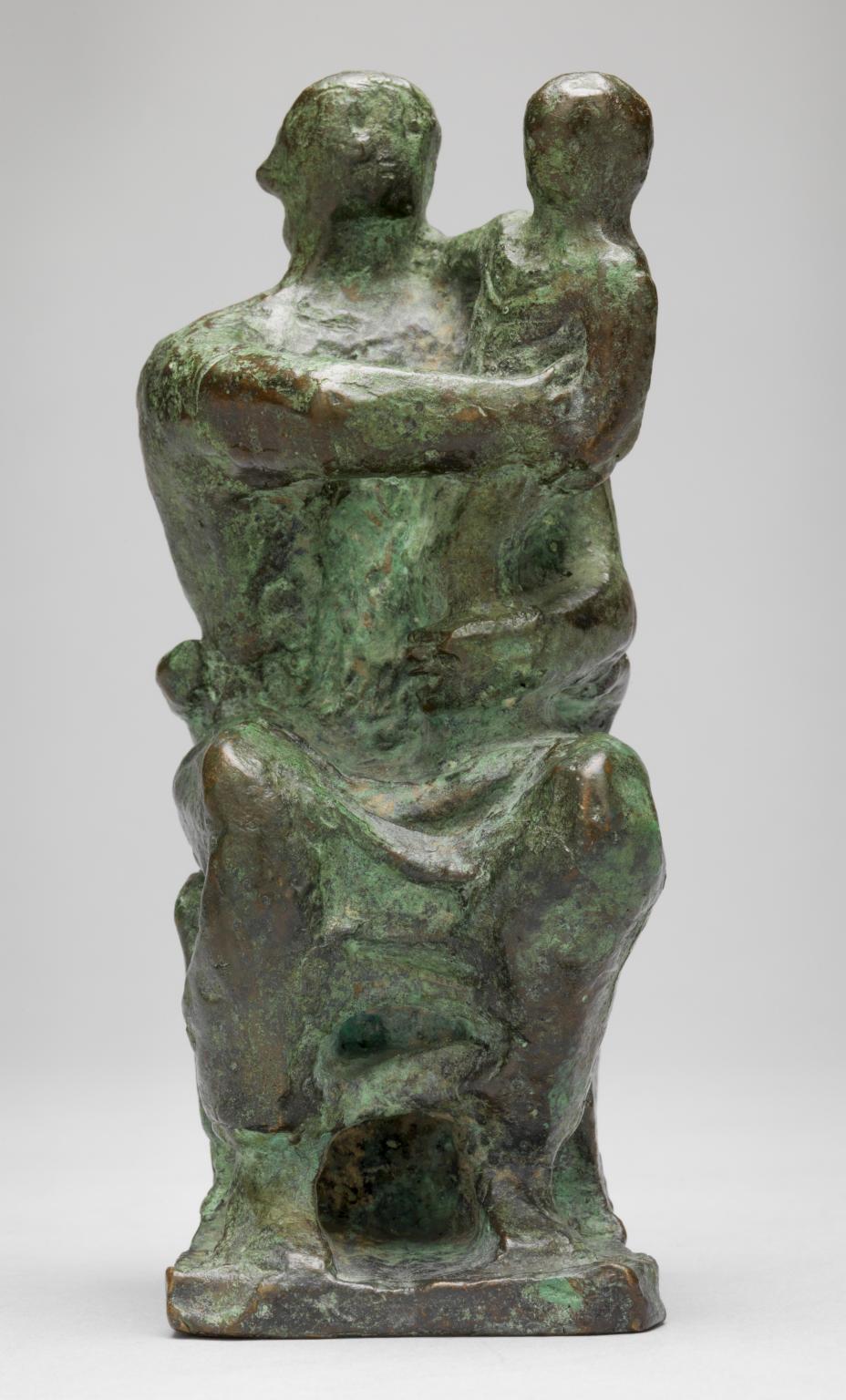
Henry Moore OM, CH, Maquette for Madonna and Child 1943, cast 1944–5
The mother and child had been a major theme in Moore’s work since the 1920s. Yet when the vicar of St Matthew, Northampton, invited Moore to make a sculpture of the Madonna and Child, he was reluctant to accept. He felt unsure how to adapt his secular interests to the Christian tradition. These bronzes are casts of the original terracotta models he made for the project. They are unusually naturalistic and steeped in references to Renaissance religious art. This suggests Moore was trying to produce a sculpture that people would find both modern and familiar.
Gallery label, September 2016
2/24
artworks in Henry Moore
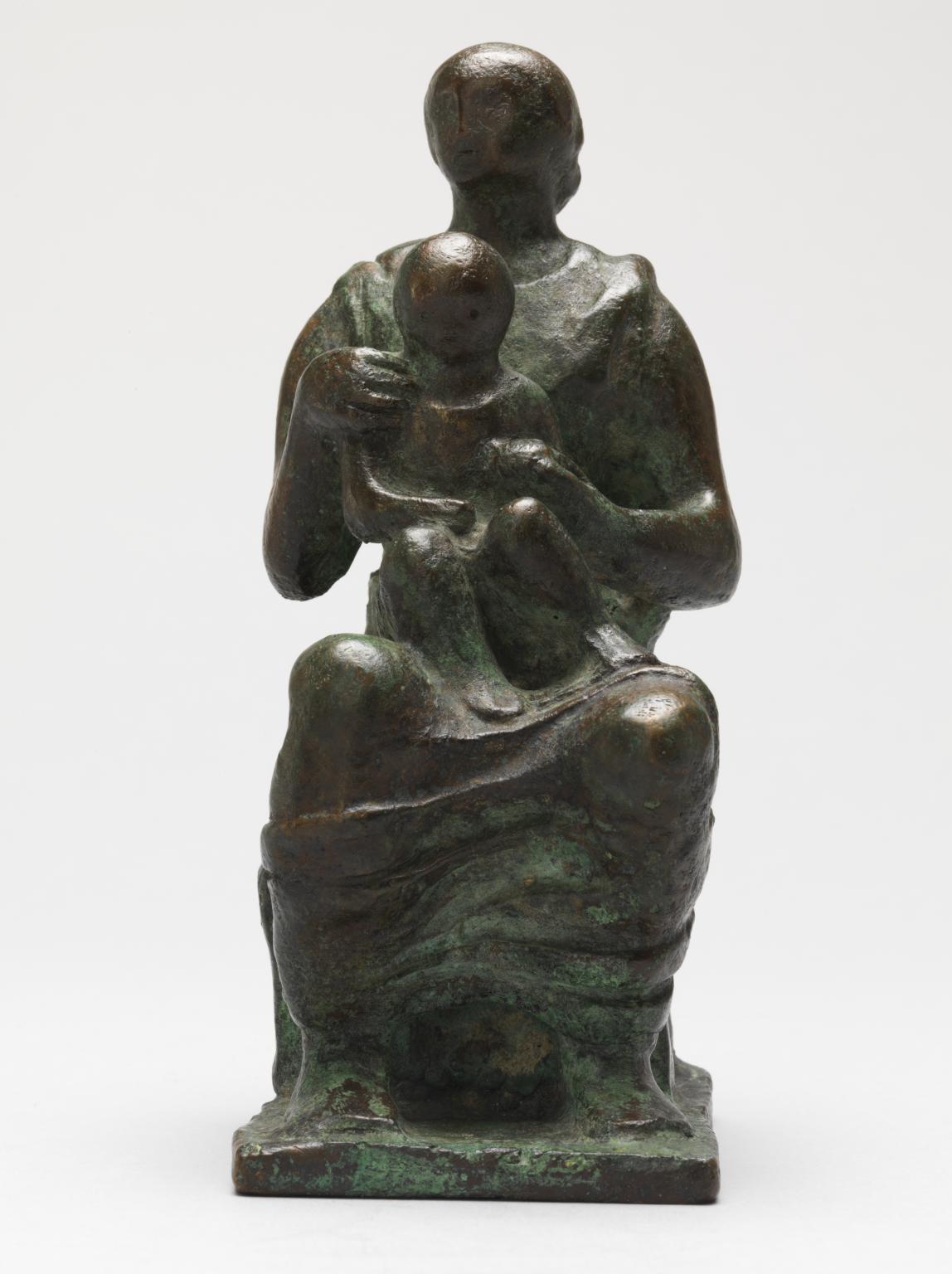
Henry Moore OM, CH, Maquette for Madonna and Child 1943, cast 1944–5
The mother and child had been a major theme in Moore’s work since the 1920s. Yet when the vicar of St Matthew, Northampton, invited Moore to make a sculpture of the Madonna and Child, he was reluctant to accept. He felt unsure how to adapt his secular interests to the Christian tradition. These bronzes are casts of the original terracotta models he made for the project. They are unusually naturalistic and steeped in references to Renaissance religious art. This suggests Moore was trying to produce a sculpture that people would find both modern and familiar.
Gallery label, September 2016
3/24
artworks in Henry Moore
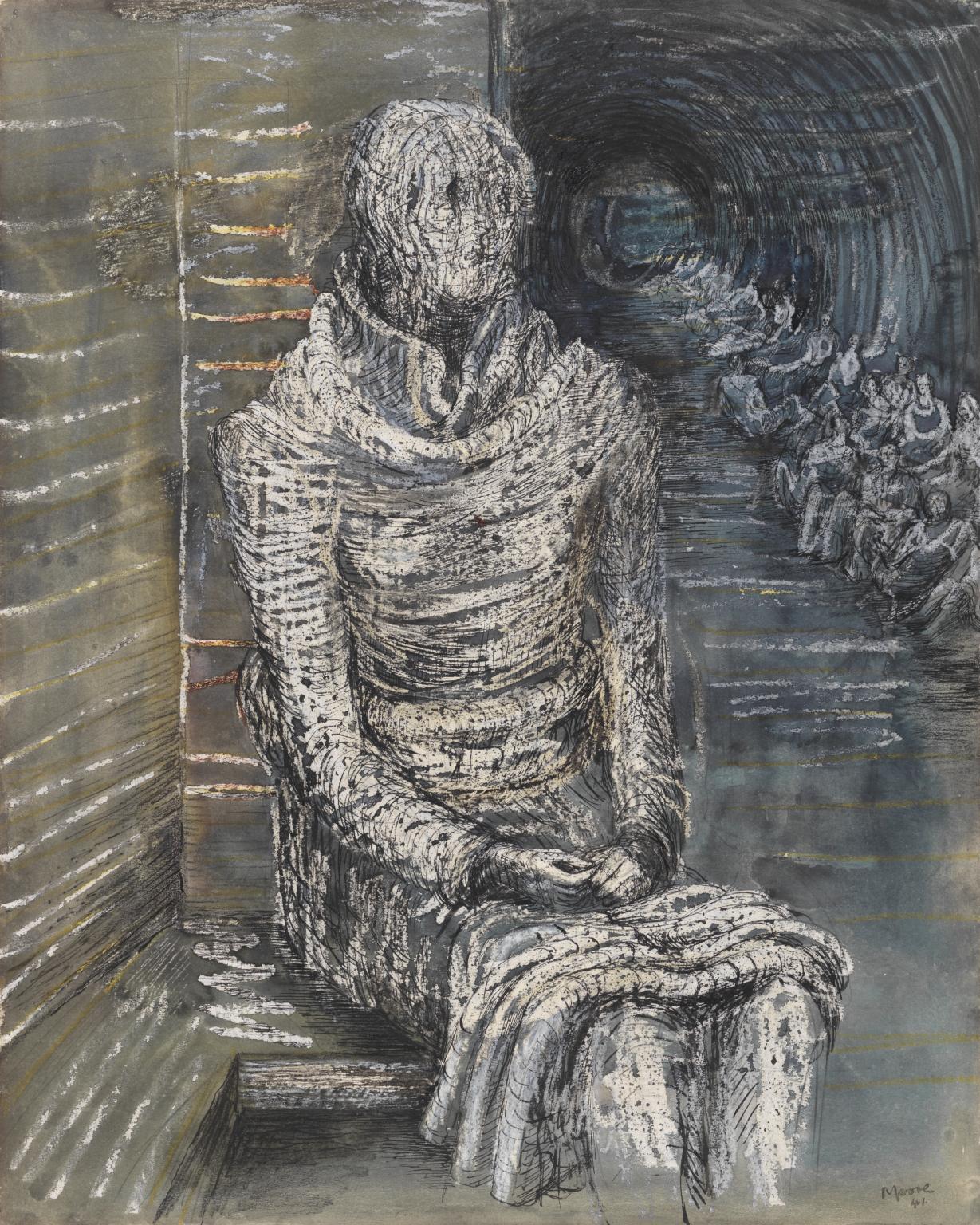
Henry Moore OM, CH, Woman Seated in the Underground 1941
Although many of the Shelter Drawings showed groups of people, some concentrated on individuals. In this picture a lone woman sits apart from the other shelterers. Swathed in layers of clothing, she stares out of the picture, anxiously clasping her hands. This sense of tension is heightened by the abrupt jump from foreground to background and the network of nervous, scratchy lines that describe the figure.
The apparent absence of period detail led some commentators to interpret such figures as timeless symbols of fear, vulnerability and endurance.
Gallery label, September 2004
4/24
artworks in Henry Moore

Henry Moore OM, CH, A Tilbury Shelter Scene 1941
During the winter of 1940-1 Moore, in his capacity as a war artist, was given access to London's public shelters. Though he concentrated on underground stations, he did make drawings of other shelters, including a vast area in the basement of a warehouse in Tilbury where he noted 'Figures lying against platform with great bales of paper above also making beds¿ Dramatic, dismal lit, masses of reclining figures fading to perspective point - Scribbles and scratches, chaotic foreground¿ Dark wet settings'.
Gallery label, September 2004
5/24
artworks in Henry Moore
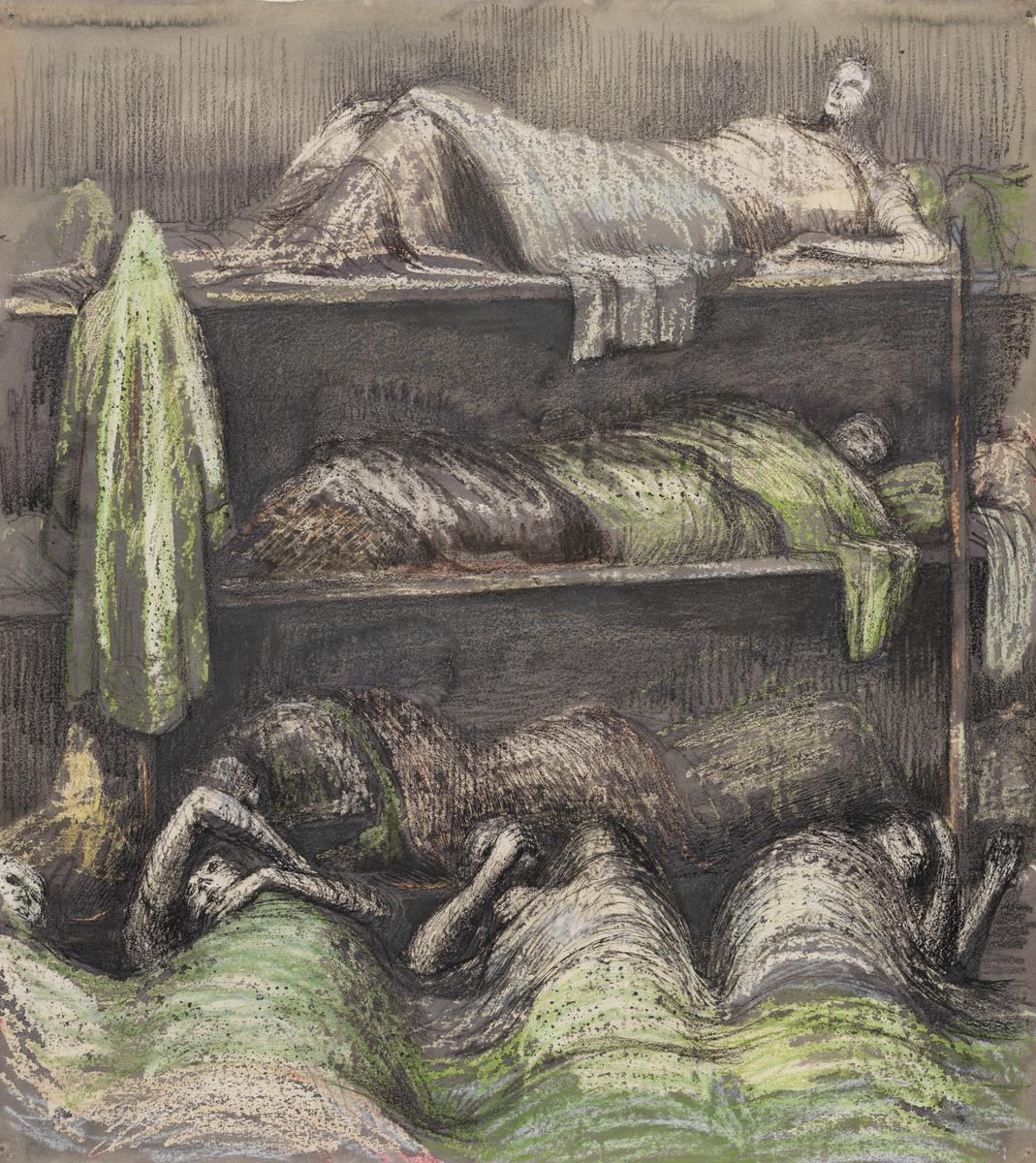
Henry Moore OM, CH, Shelter Scene: Bunks and Sleepers 1941
This picture was exhibited at an exhibition called War Pictures at the National Gallery in 1941. It was also reproduced in the exhibition catalogue. In his catalogue essay, the critic Eric Newton compared the war between Germany and Britain to 'the fundamental opposition between the sea's restless power and the land's opposing firmness'. The wave-like undulations of the figures lying in the foreground of the drawing and the vertical cliff of figures on the bunks correspond remarkably with Newton's analogy.
Gallery label, September 2004
6/24
artworks in Henry Moore
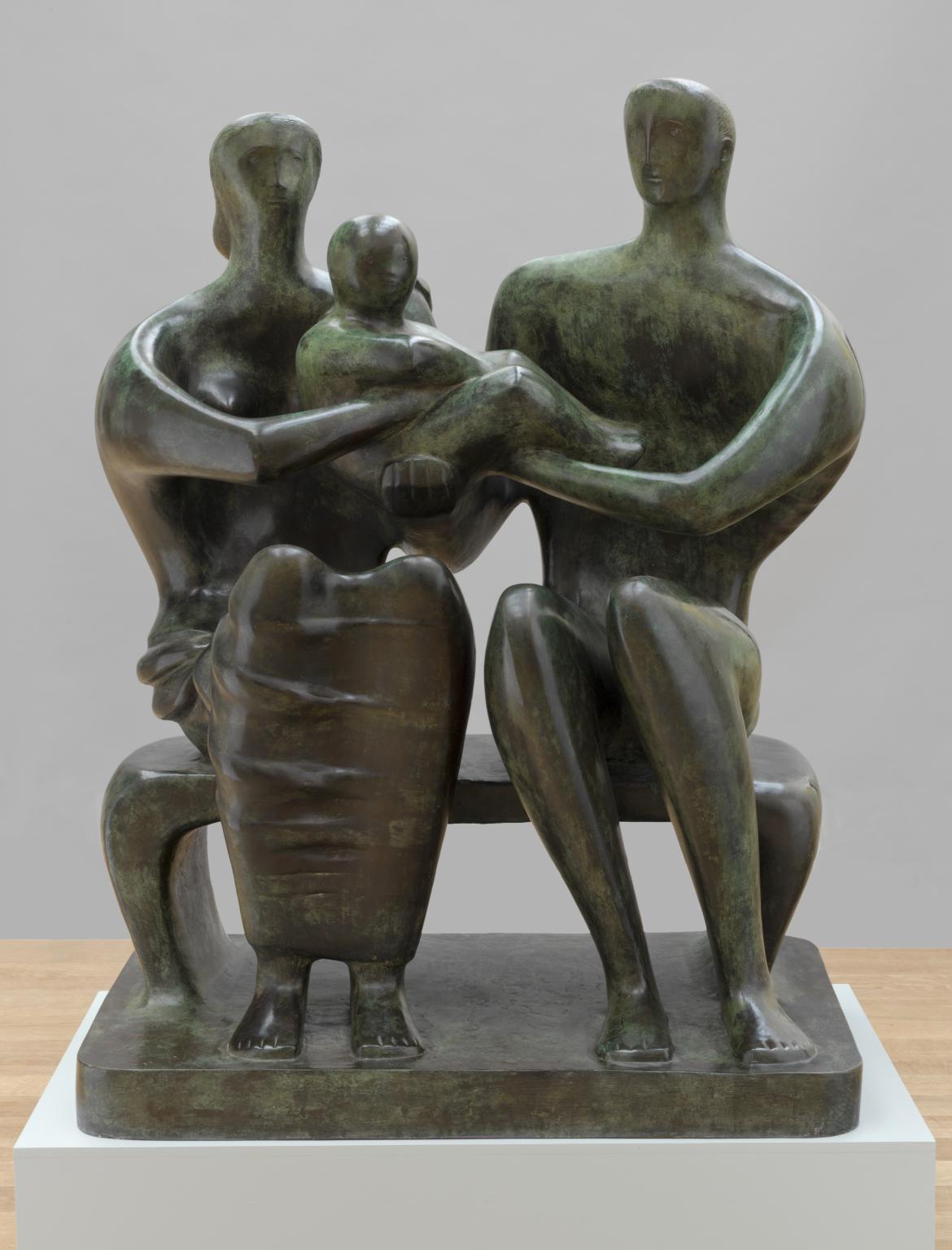
Henry Moore OM, CH, Family Group 1949, cast 1950–1
Family Group is derived from one of a number of maquettes that Moore made for a sculpture for Impington Village College in Cambridgeshire. In the end none of them was accepted. Several years later, however, he was approached to make a sculpture for the Barclay Secondary School in Stevenage and returned to the theme. The bronze was cast in an edition of four. One is still at the Barclay Secondary School. The others were acquired by the Museum of Modern Art in New York, Nelson D Rockefeller, and Tate.
Gallery label, September 2004
7/24
artworks in Henry Moore
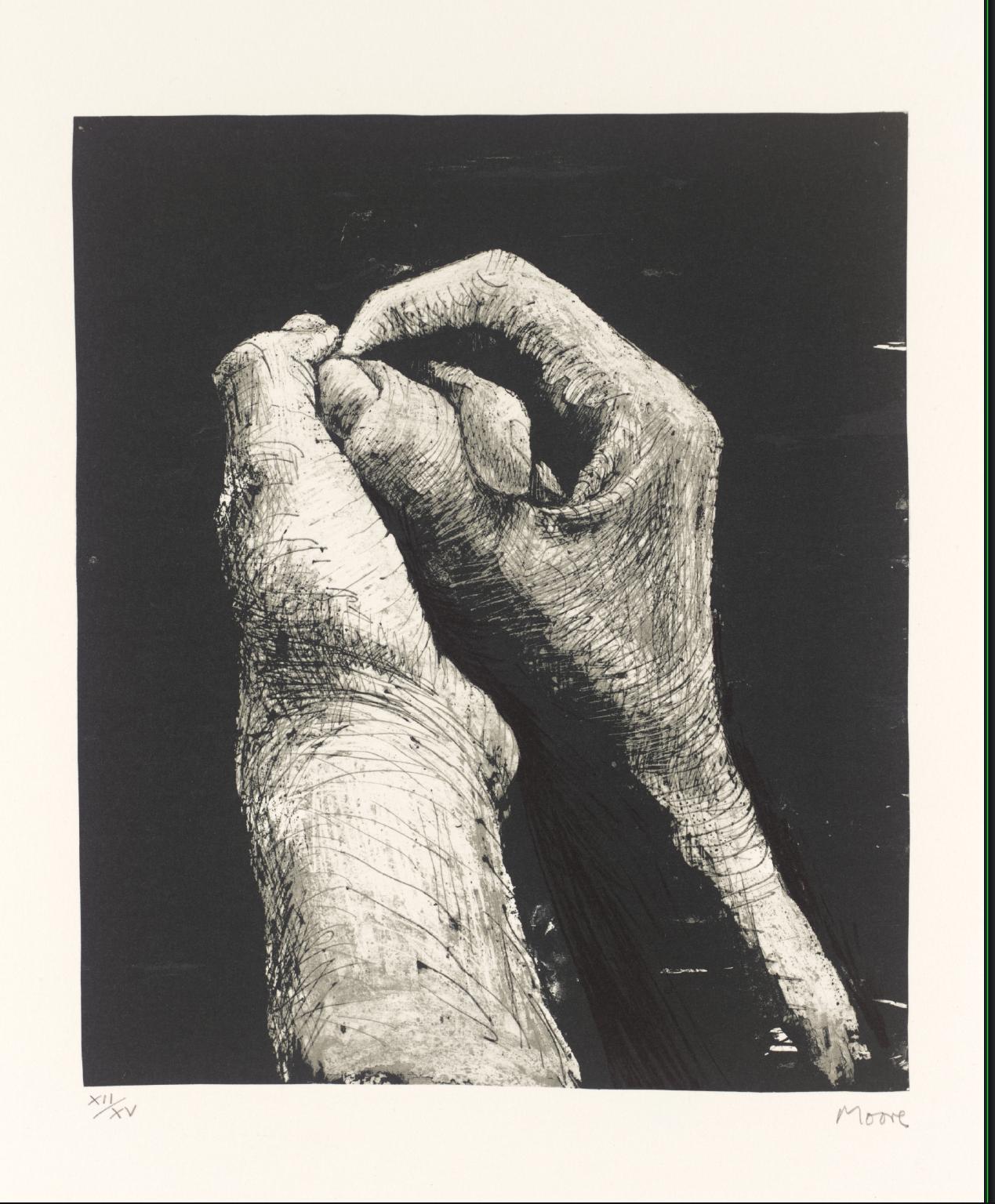
Henry Moore OM, CH, Hands II 1973
8/24
artworks in Henry Moore
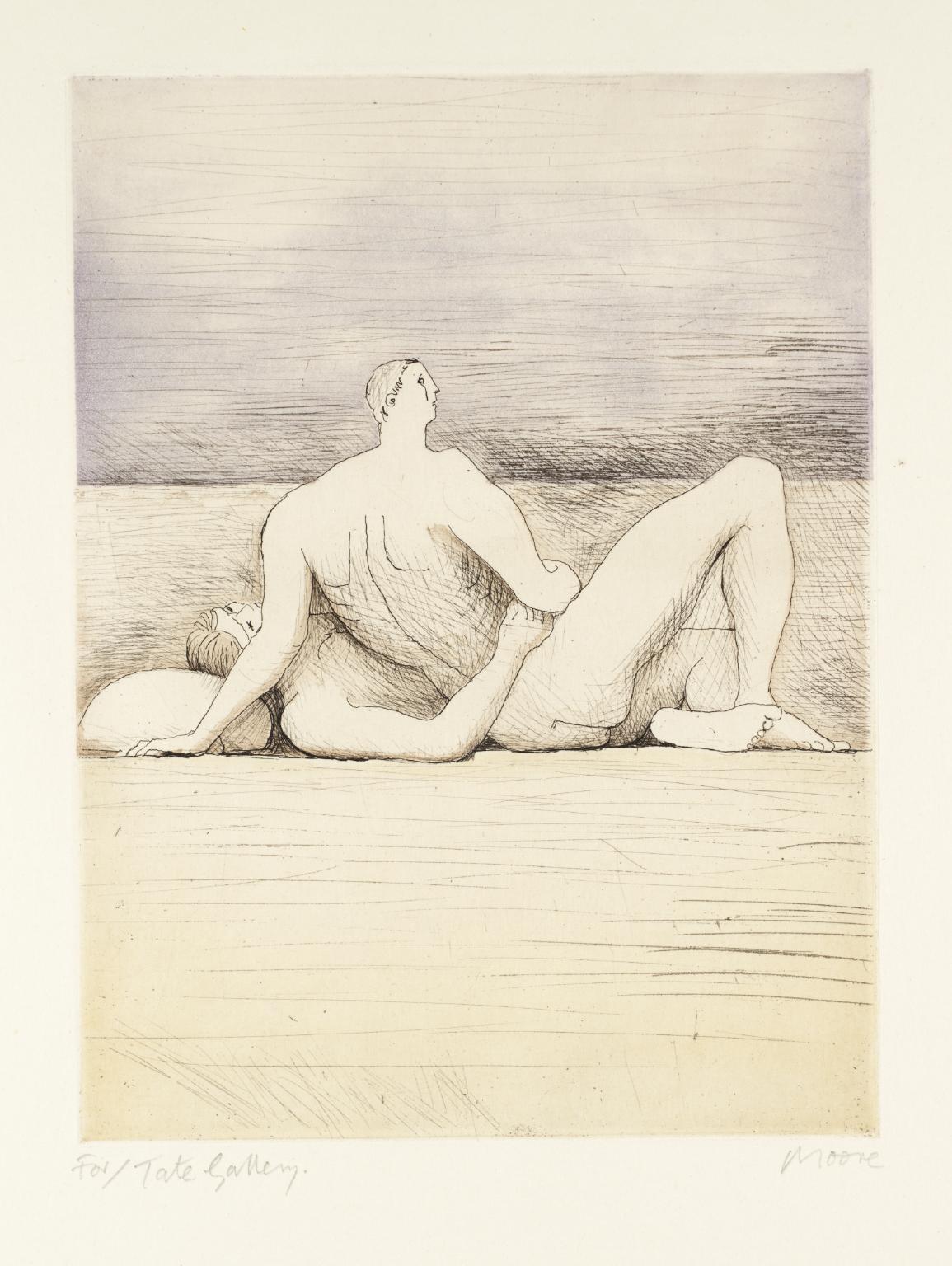
Henry Moore OM, CH, Reclining Figures Man and Woman II 1975
9/24
artworks in Henry Moore
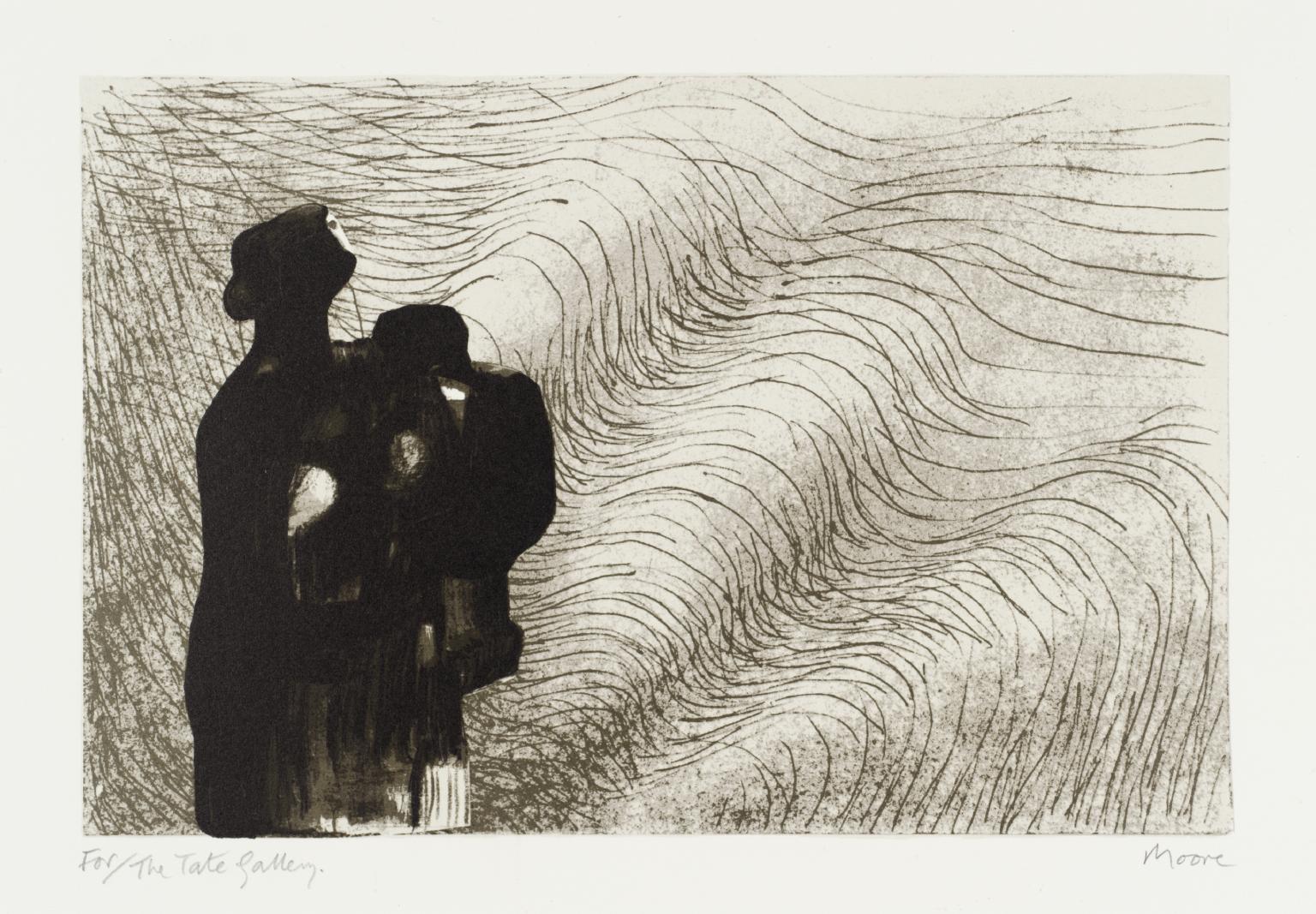
Henry Moore OM, CH, Mother and Child with Wave Background I 1976
10/24
artworks in Henry Moore
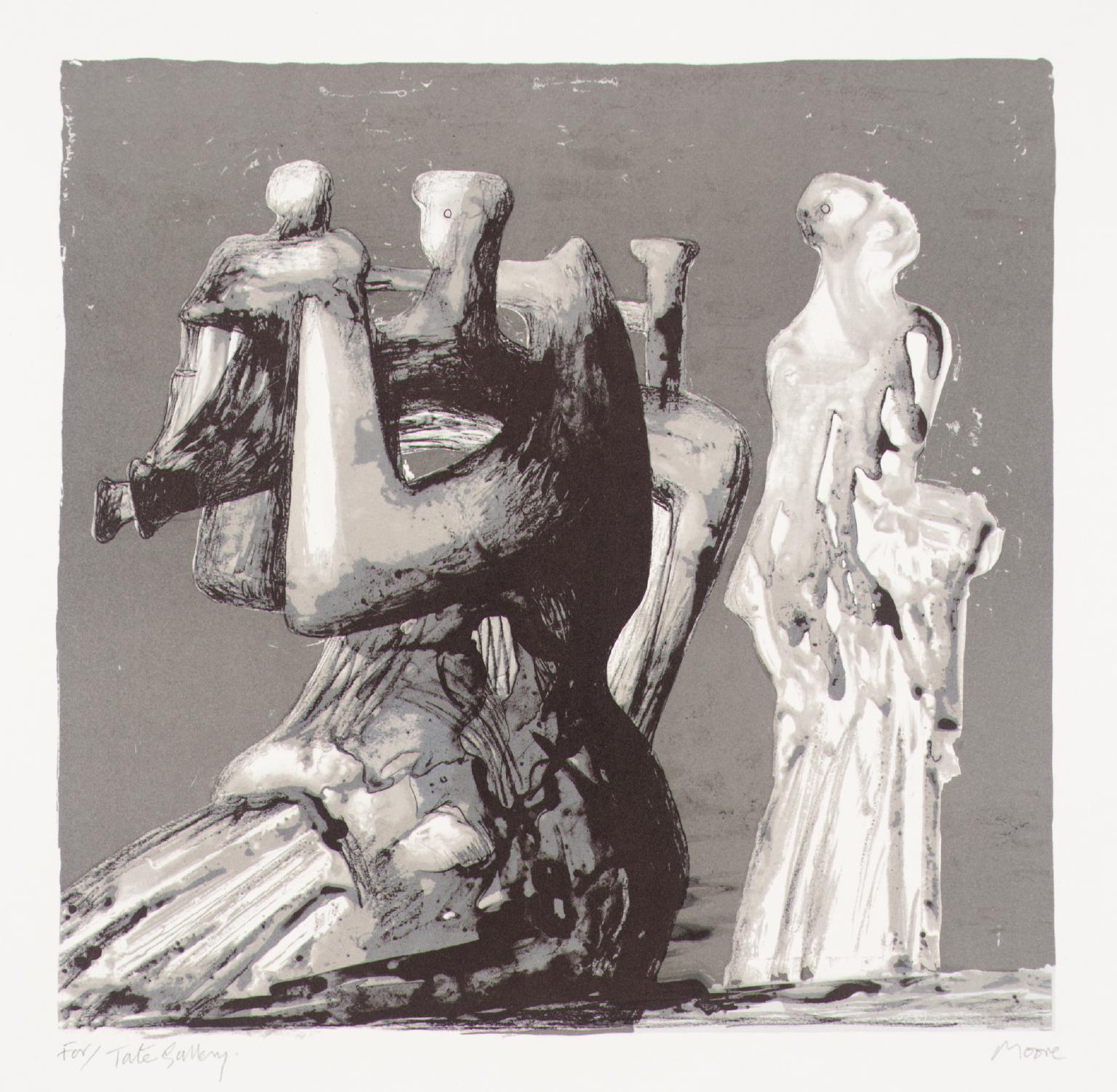
Henry Moore OM, CH, Mother and Child with Dark Background 1976
11/24
artworks in Henry Moore
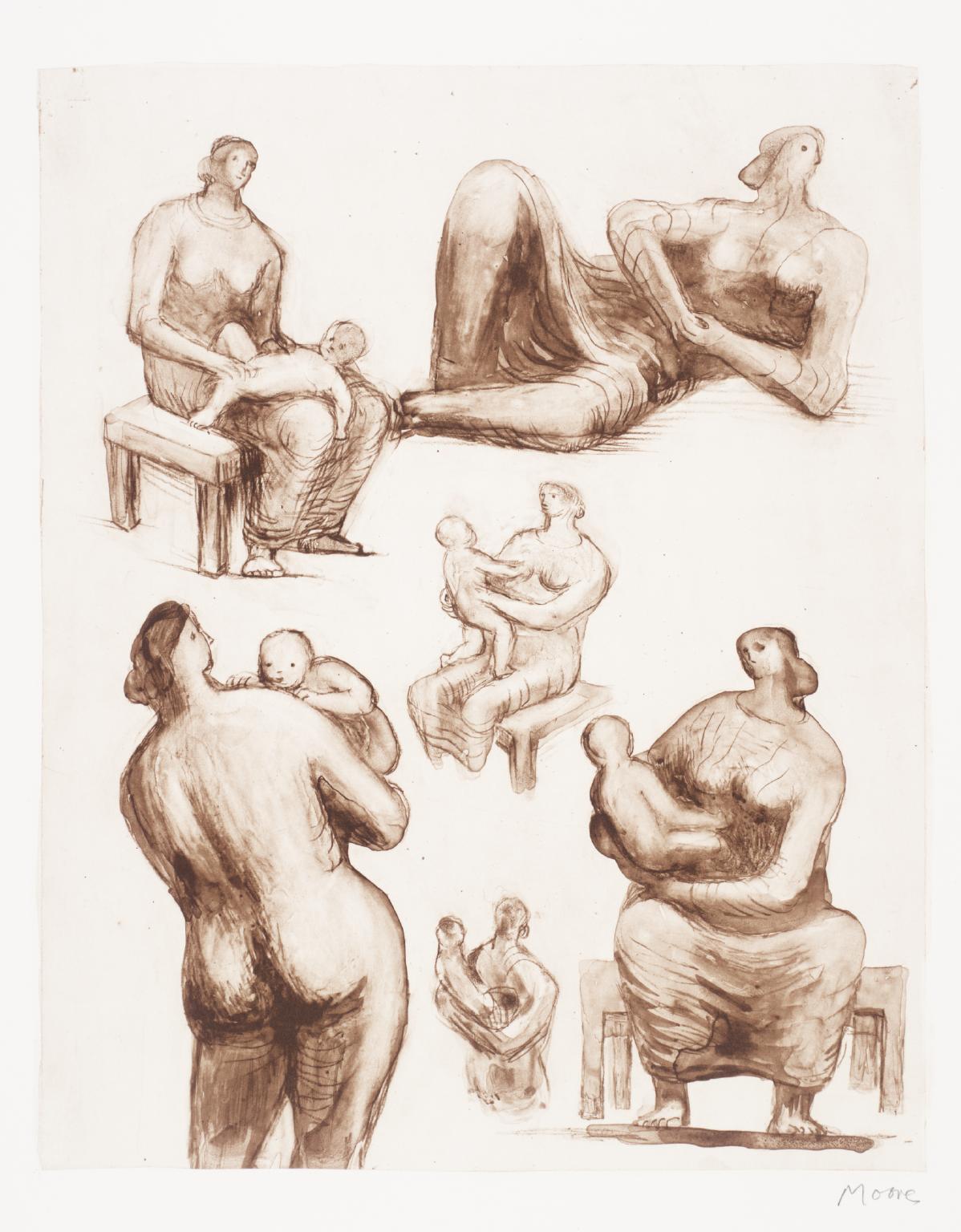
Henry Moore OM, CH, Mother and Child Studies and Reclining Figure 1977
12/24
artworks in Henry Moore
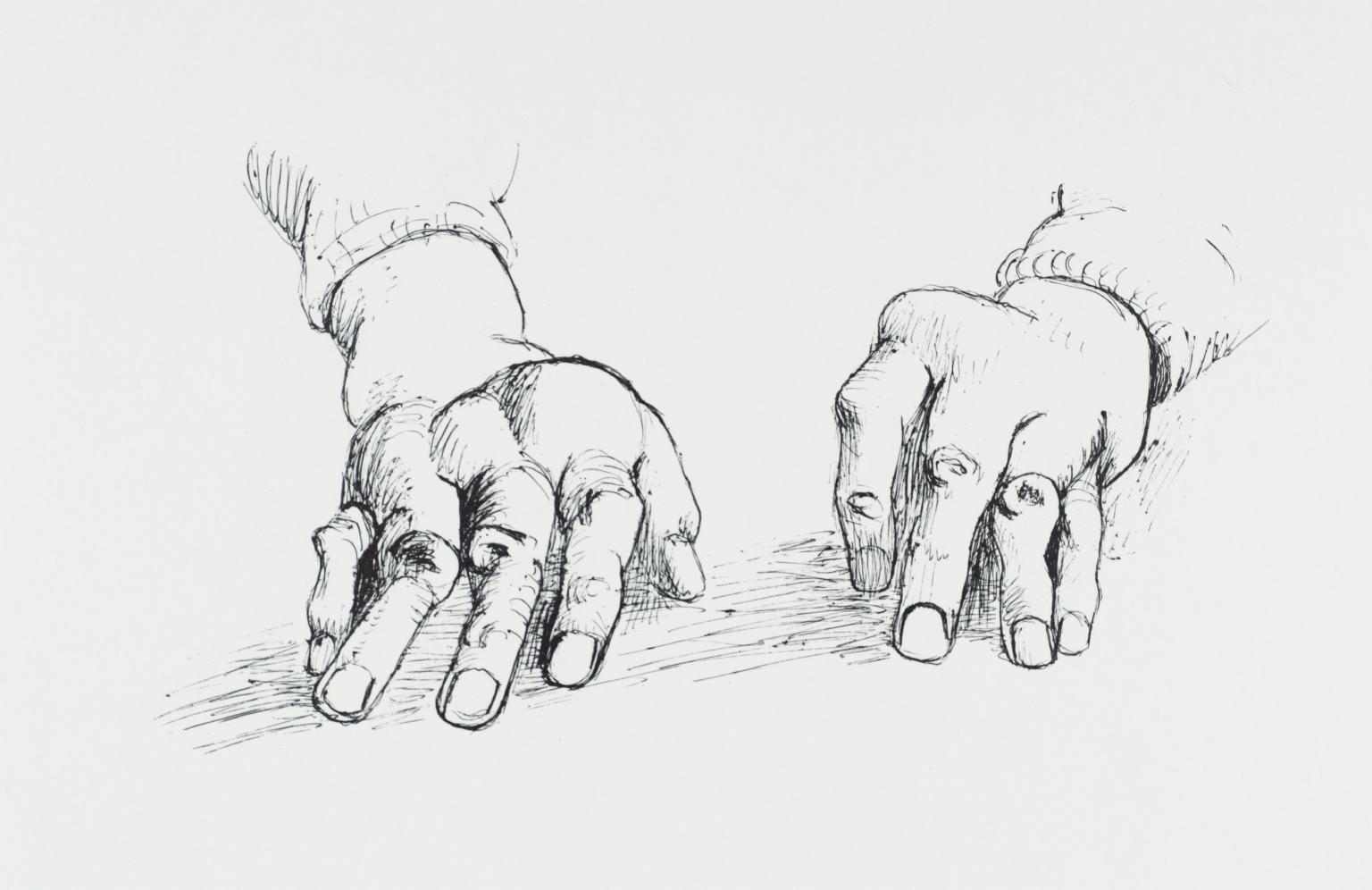
Henry Moore OM, CH, Hands of Dorothy Crowfoot Hodgkin I 1978
13/24
artworks in Henry Moore
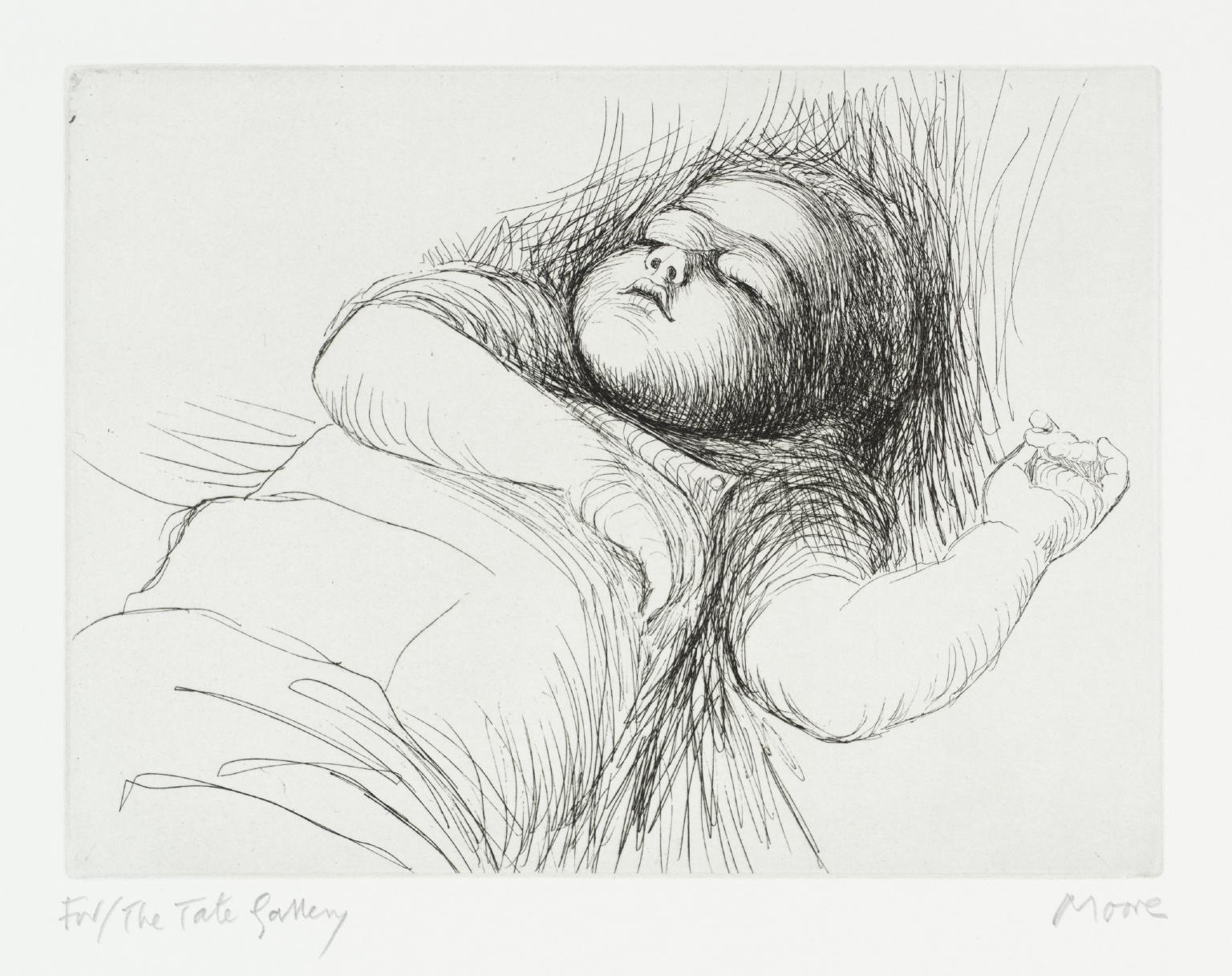
Henry Moore OM, CH, Sleeping Child 1979
14/24
artworks in Henry Moore

Henry Moore OM, CH, Trees V Spreading Branches 1979
15/24
artworks in Henry Moore
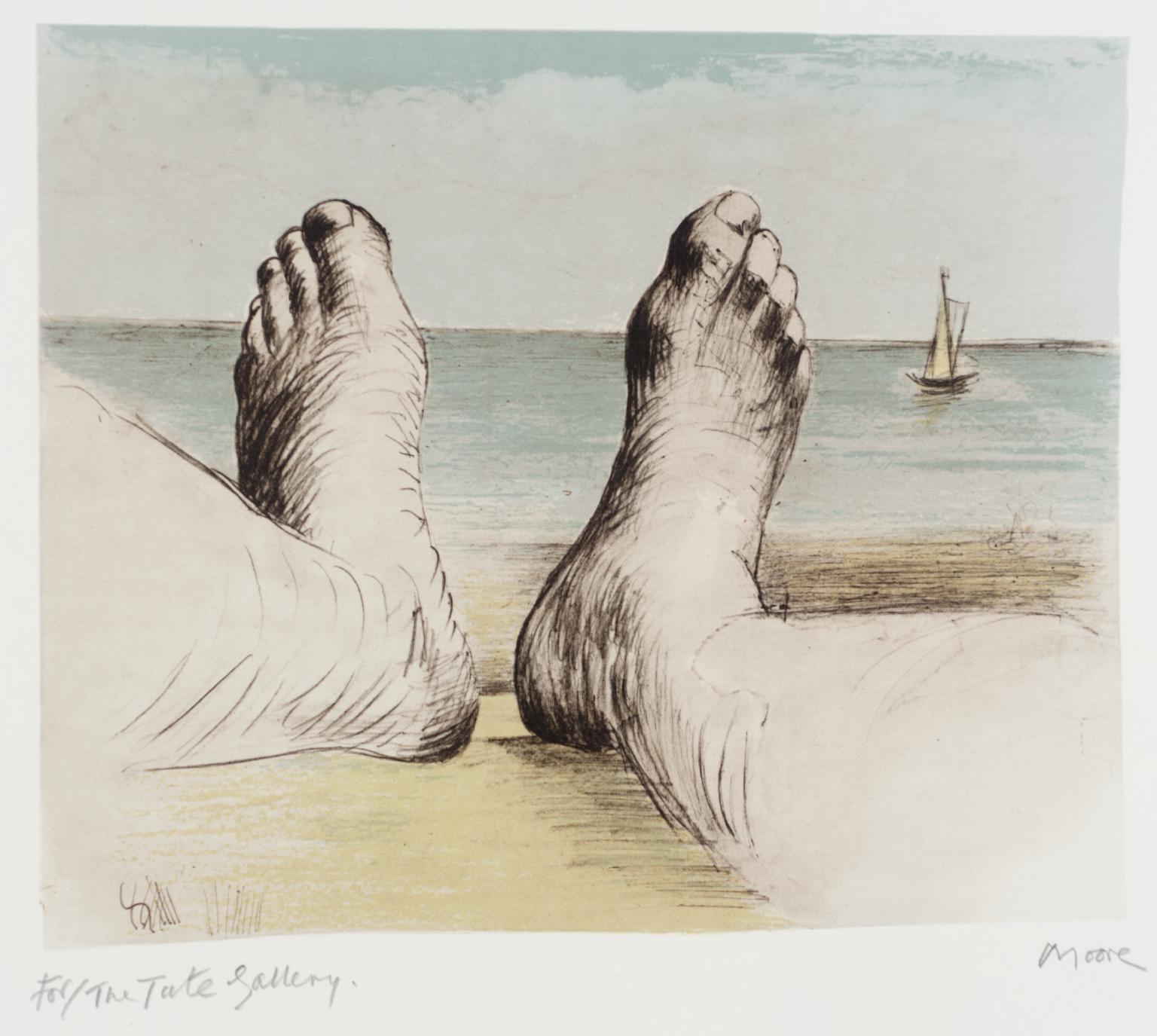
Henry Moore OM, CH, Feet on Holiday I 1979
16/24
artworks in Henry Moore
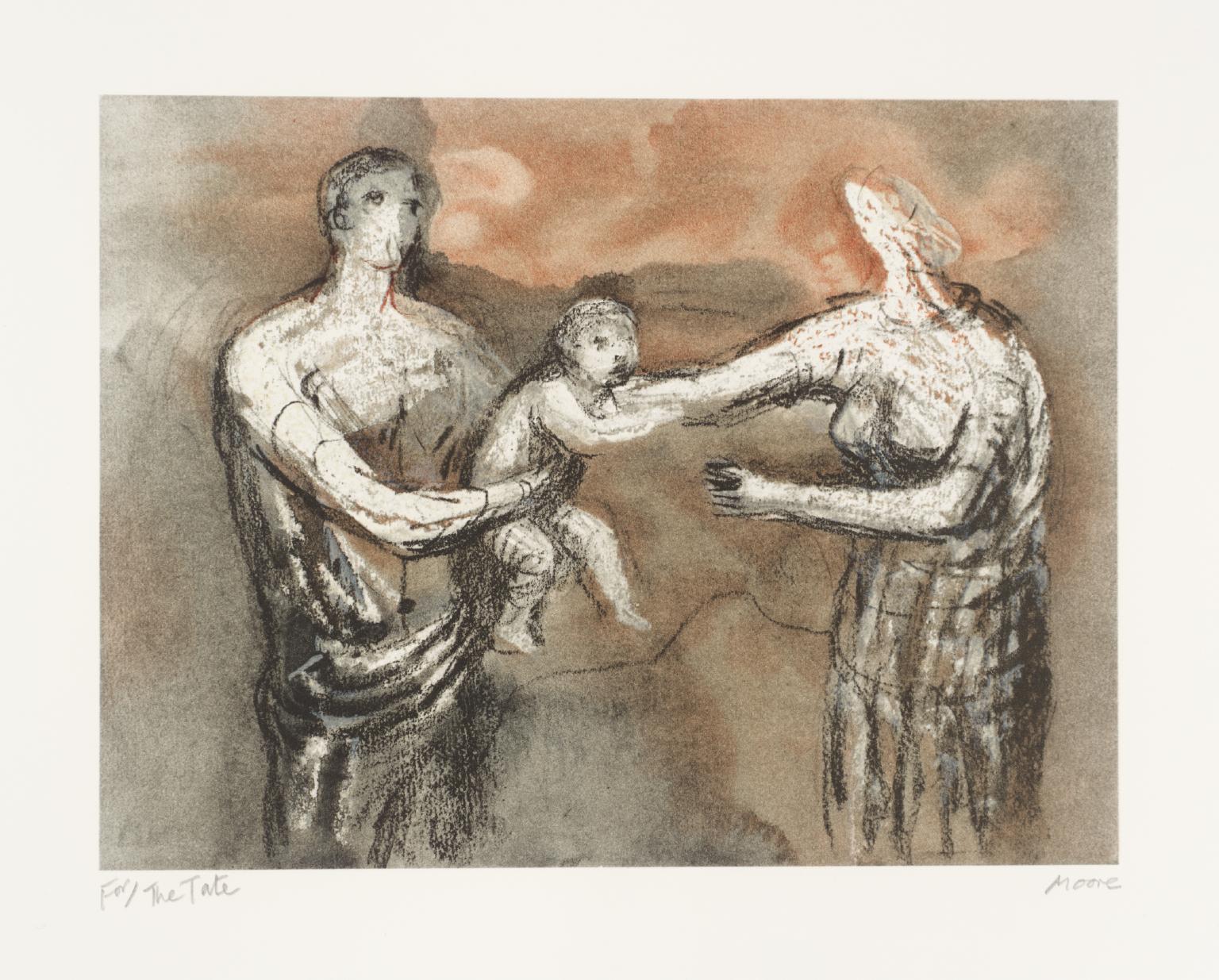
Henry Moore OM, CH, Family Group 1984
17/24
artworks in Henry Moore
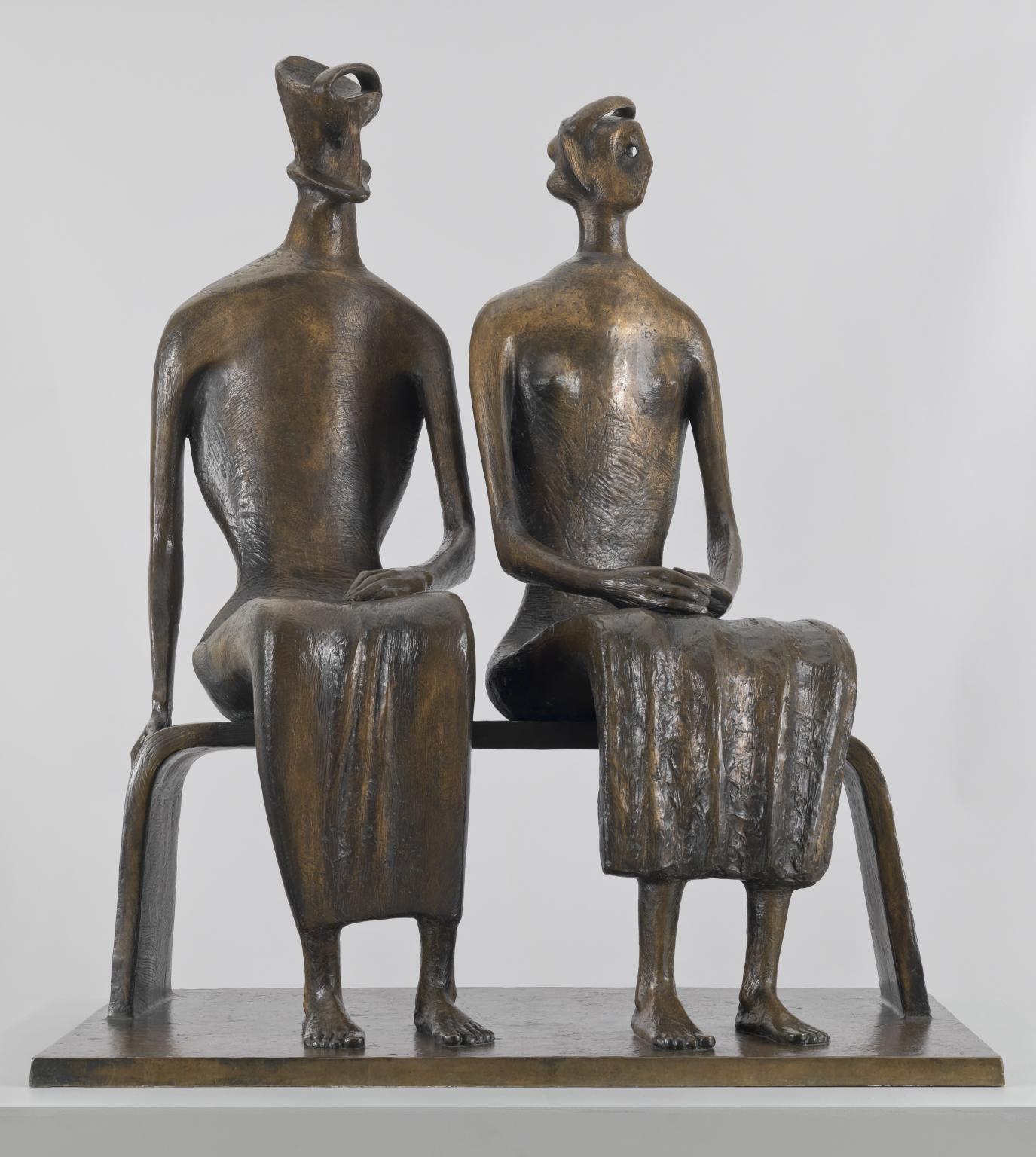
Henry Moore OM, CH, King and Queen 1952–3, cast 1957
Although this sculpture was made around the time of Elizabeth II’s coronation, its subject is not the modern constitutional monarchy. Instead it focuses on the ancient conception of the monarch as a divine or divinely blessed being.
Moore has combined naturalistic elements, for example the hands and feet, with more abstracted or primitivised ones, such as the heads. His intention was to suggest the blend of the human and celestial within kingship. This image of stable and benevolent authority resonated widely in the post-war climate of uncertainty.
Gallery label, August 2004
18/24
artworks in Henry Moore
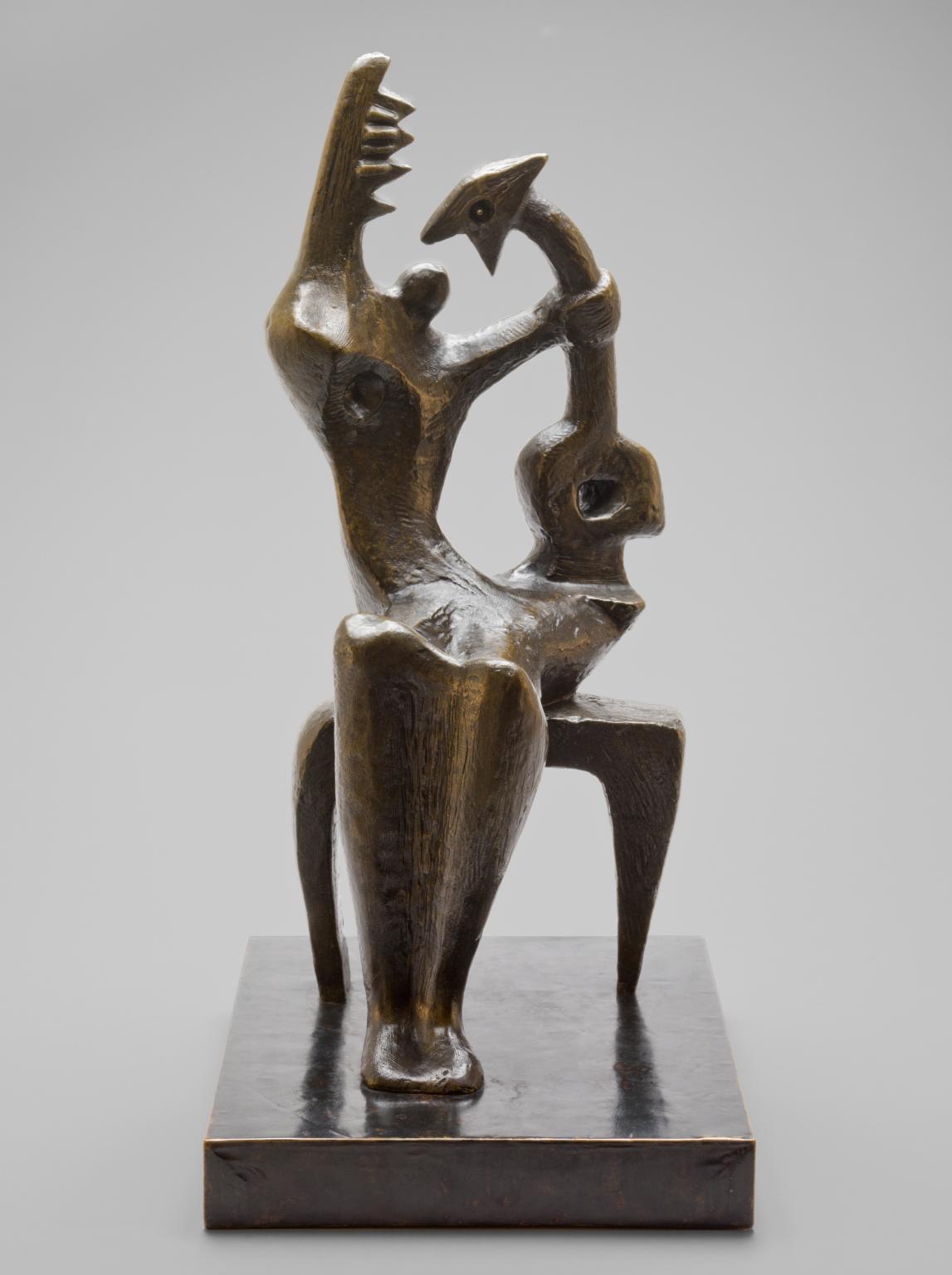
Henry Moore OM, CH, Mother and Child 1953, cast c.1954
Moore treated the subject of mother and child repeatedly. This sculpture is one of a group of small bronzes made by the artist during the early 1950s that focus specifically on the relationship between mother and child. During the Second World War Moore's interpretation of the theme emphasised the mother's nurturing role, a response to the human suffering of war. He continued to explore this aspect of the subject in the 1950s. Here he distorts the figures to suggest the submission of the mother to the aggressive needs of the child as it tries to suckle from her breast.
Gallery label, February 2010
19/24
artworks in Henry Moore
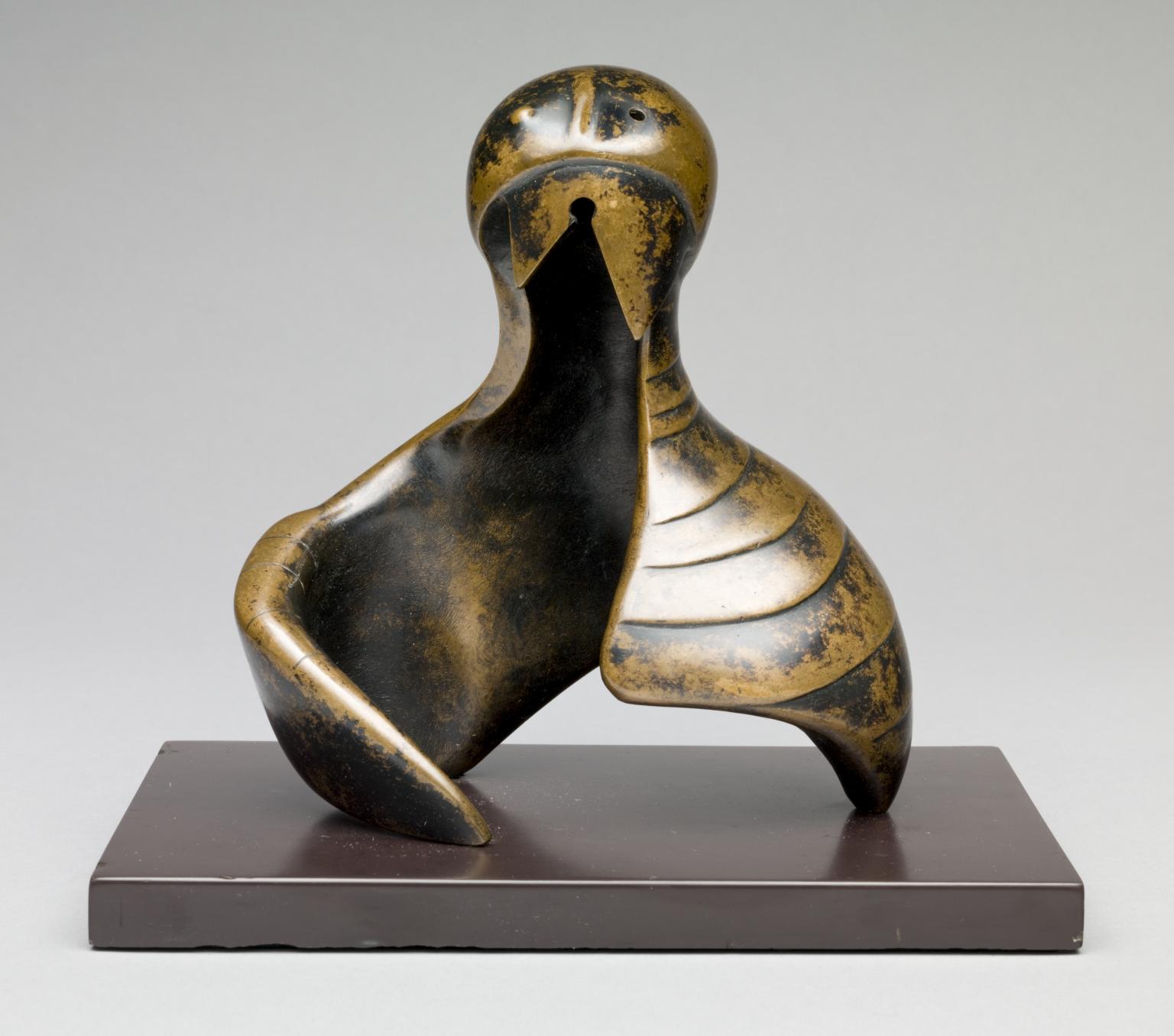
Henry Moore OM, CH, Helmet Head and Shoulders 1952, cast date unknown
British sculptor Henry Moore once described the helmet motif as ‘a recording of things inside other things’. It was related to a major theme in his work: the mother and child. While some of Moore’s sculptures present this relationship as benign and nurturing, other works suggest something more mysterious and ambiguous. Although the protective wings gently envelop the interior void, the toothed visor and claw shape impart a sense of menace, even aggression. The scuffed patina implies some ancient, battle-scarred creature.
Henry Moore was born in Castleford, West Yorkshire in 1898 and died near Much Hadham, Hertfordshire in 1986.
Gallery label, August 2004
20/24
artworks in Henry Moore

Henry Moore OM, CH, Falling Warrior 1956–7, cast c.1957–60
Moore was internationally famous for sculptures of female figures when, in the mid- 1950s, he produced a number of sculptures of vulnerable males. For these he looked to classical precedents, photographs and such other sources as the plaster casts of the victims of Pompeii. These suffering male figures spoke, perhaps, to current Cold War anxieties and memories of recent warfare.
Gallery label, September 2016
21/24
artworks in Henry Moore
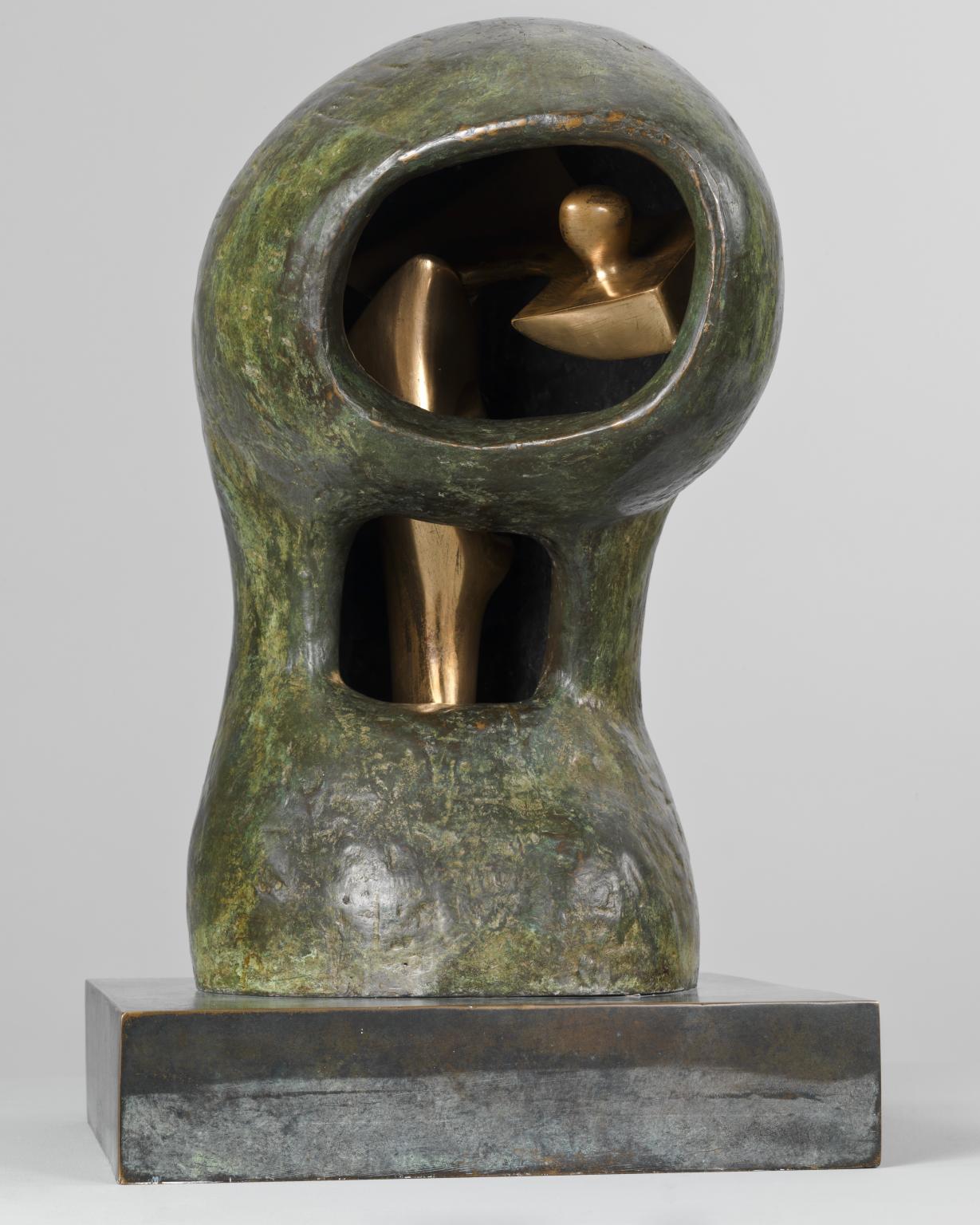
Henry Moore OM, CH, Helmet Head No.4: Interior-Exterior 1963, cast date unknown
Moore made a sequence of Helmet Head pieces that were intended to convey emotions of vulnerability and protection. He explained the idea partly came from ‘Wyndham Lewis talking about the shell of lobster covering the soft flesh inside. This became an established idea with me – that of an outer protection to an inner form, and it may have something to do with the mother and child idea ... The helmet is a kind of protection thing, too, and it became a recording of things inside other things. In the helmet you do not quite know what is inside.’
Gallery label, February 2010
22/24
artworks in Henry Moore
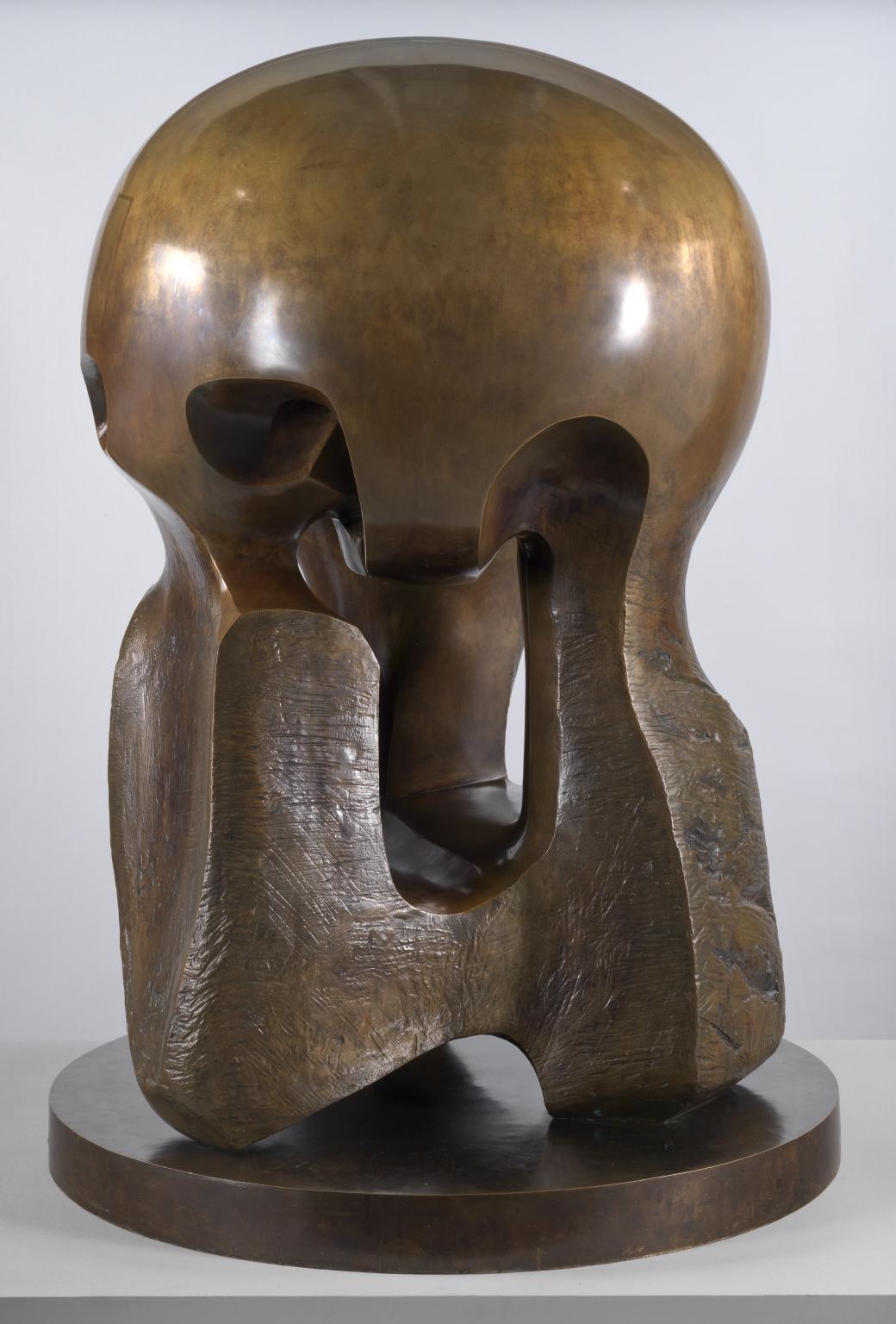
Henry Moore OM, CH, Atom Piece (Working Model for Nuclear Energy) 1964–5, cast 1965
In 1963 Moore was invited by the University of Chicago to make a sculpture commemorating the first controlled nuclear chain reaction, which had been conducted at the university in 1942. Nuclear Energy, which is shown in the photograph above, was unveiled in 1967. This sculpture is a working model for Nuclear Energy. Moore intended it to suggest ‘a contained power and force’ appropriate to the subject. Its shape suggests a human skull and a mushroom cloud. In 1987, the city of Hiroshima, which had been destroyed by a nuclear bomb in 1945, purchased one of the seven casts.
Gallery label, September 2004
23/24
artworks in Henry Moore
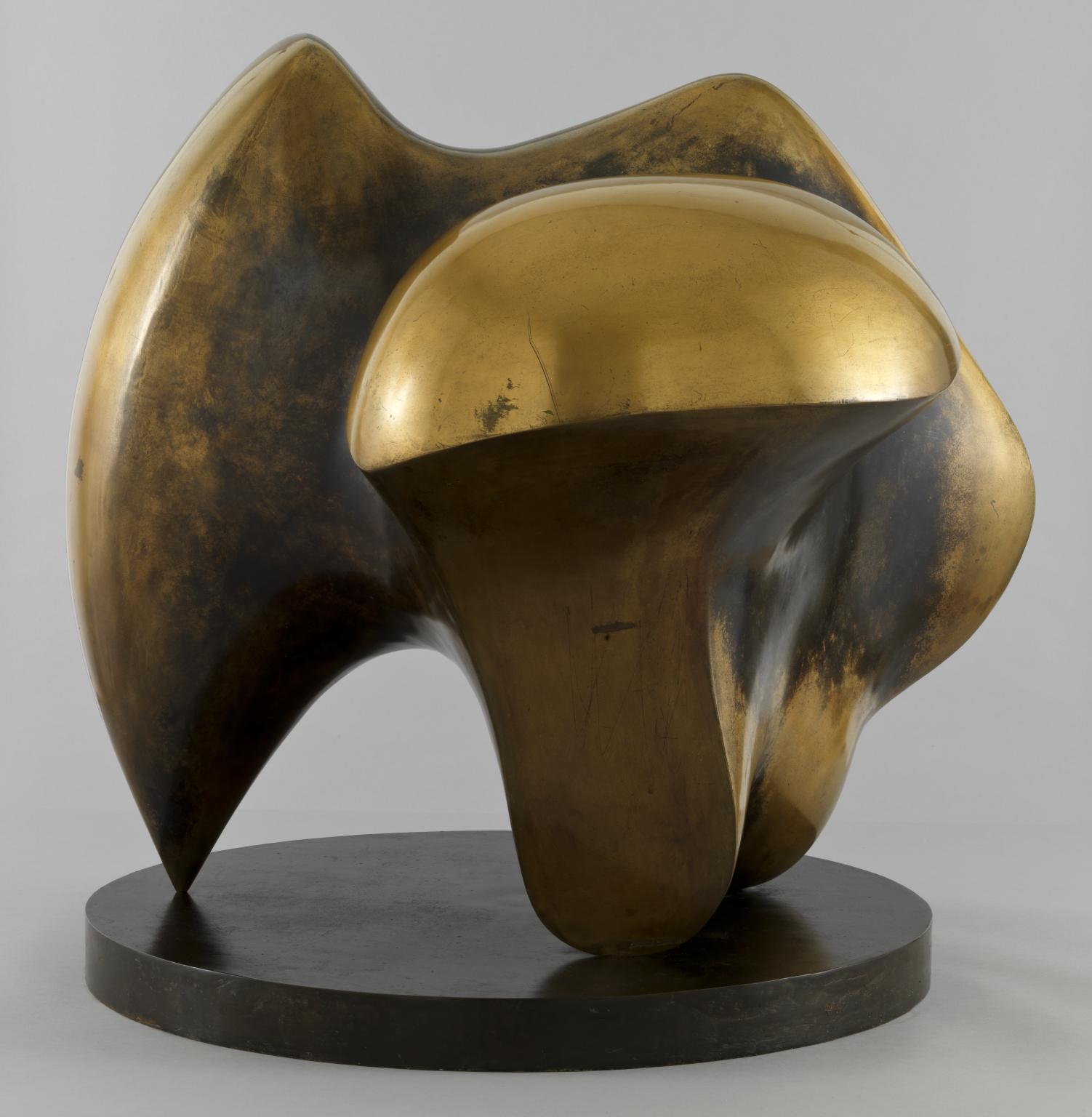
Henry Moore OM, CH, Working Model for Three Way Piece No.1: Points 1964, cast c.1964–9
24/24
artworks in Henry Moore
Art in this room
























You've viewed 6/24 artworks
You've viewed 24/24 artworks
